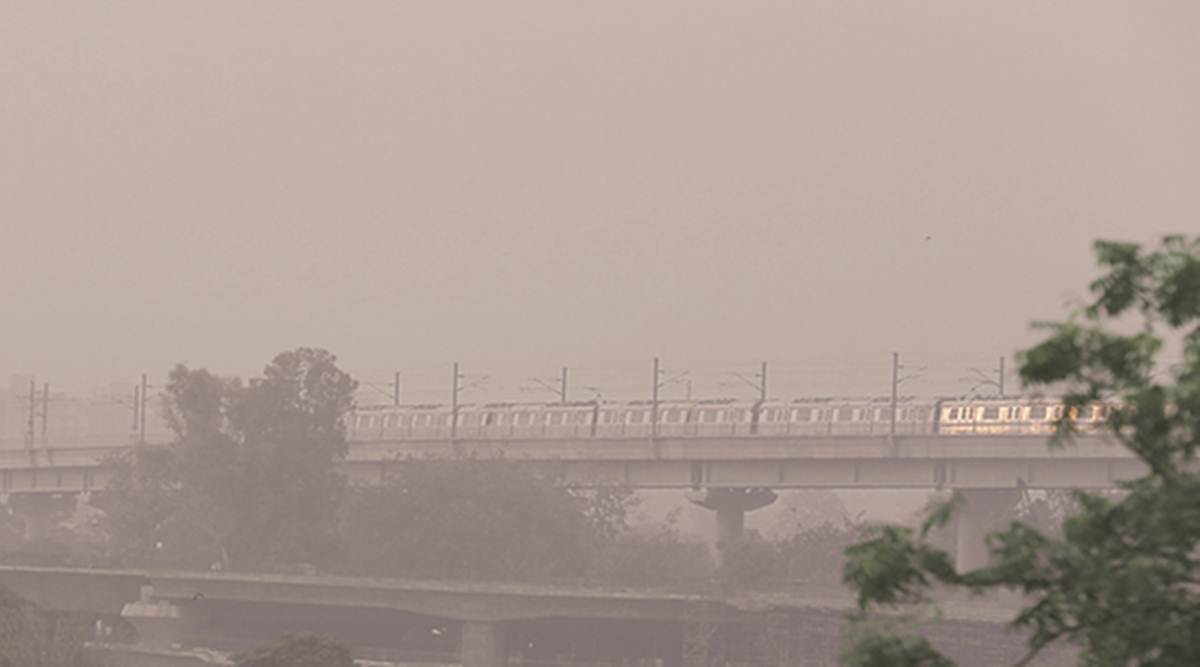 AQI remained in the ‘very poor’ category since around 9.30 am on Tuesday until at least 4 pm
AQI remained in the ‘very poor’ category since around 9.30 am on Tuesday until at least 4 pmDelhi’s air quality further deteriorated Tuesday and was recorded in the ‘very poor’ category for most part of the day, which officials said is mainly a result of unfavourable weather conditions. Wind speed over the city dropped to nearly zero between 7 pm on Monday and 8 am on Tuesday and the minimum or the night time temperature was 19.8 degrees Celsius, as per the India Meteorological Department.
These two weather conditions reduced the atmospheric mixing layer or the vertical height in which pollutants are suspended, causing the concentration of particulate matter of 2.5 and 10 micrometres (PM 2.5, PM 10) — fine particles suspended in the air that can enter the bloodstream through breathing — to more than double overnight, officials said.
The average air quality index (AQI) of the city on Tuesday was recorded on the border of ‘poor’ and ‘very poor’ categories with a reading of 300, as per data from the Central Pollution Control Board (CPCB).
A forecast from the Central government’s SAFAR air quality and weather forecasting system said, “In Delhi, the development of strong surface-level inversion and sudden calm wind conditions led to a low ventilation coefficient and accumulation of pollutants near the surface.”
An inversion is when temperature near the surface is lower than the temperature at a higher altitude, which puts a cap on the upward movement of air and hinders diffusion of pollutants trapped near the surface.
Ventilation coefficient is the sum of the mixing layer and the average wind speed. A ventilation coefficient below 6,000 sqm/second is unfavourable for dispersion for pollutants. In Delhi, it is forecast to remain around that value until Thursday.
AQI remained in the ‘very poor’ category since around 9.30 am on Tuesday until at least 4 pm, when 17 out of 34 air monitoring stations were in the ‘very poor’ range, as per the CPCB. Areas with high levels of air pollution included Wazirabad, Mundka and Dwarka.
Delhi government officials said deterioration in air quality is mainly being caused by weather conditions. “All the industries have been running on CNG, there is no sudden surge of vehicles on road and traffic congestion is also not very high. We are also constantly monitoring dust emissions at construction sites and imposing fines for non-compliance of norms,” a Delhi government official said.
Until Monday evening, the wind direction over the city was from the northwest, which was favourable for transport of pollutants from stubble burning states of Punjab and Haryana. However, as per SAFAR, farm fires had 3% contribution to Delhi’s PM 2.5 levels on both Monday and Tuesday.
As of 5 pm on Tuesday, the concentration of PM 10 in Delhi-NCR was 289.6 micrograms per cubic metre air (µg/m3), nearly three times the average safe limit of 100 µg/m3. Concentration of PM 2.5 was 126.6 µg/m3, more than double the average acceptable limit of 60 µg/m3. A month ago, levels of both PM10 and PM2.5 were nearly half of those recorded on Tuesday.
Kuldeep Srivastava, head of the IMD’s regional weather forecasting centre in Delhi, said after 7 pm on Monday, the winds became calm until 8 am on Tuesday, following which the wind direction changed to east-southeast. “In the transition phase, when wind direction is about to change, accumulation of pollutants is often noted. After 8 am, the wind speed picked up to 10-12 kmph but that is not enough for dispersion of pollutants,” he said.
Srivastava added that wind direction is not expected to change for the next few days and, therefore, contribution of pollutants from farm fires will be minimal, but low wind speed is forecast to continue, which may hinder dispersion of emissions from local sources.
The SAFAR forecast added, “Calm night time surface wind condition is likely to continue for the next two days. AQI is likely to be in the very poor to poor category for the next two days.”
📣 The Indian Express is now on Telegram. Click here to join our channel (@indianexpress) and stay updated with the latest headlines
For all the latest Delhi News, download Indian Express App.